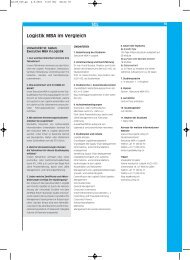The link between supply chain fit and financial - MBA, Supply Chain ...
The link between supply chain fit and financial - MBA, Supply Chain ...
The link between supply chain fit and financial - MBA, Supply Chain ...
Create successful ePaper yourself
Turn your PDF publications into a flip-book with our unique Google optimized e-Paper software.
Return on Assets, ROA) as an outcome of <strong>supply</strong> <strong>chain</strong> <strong>fit</strong> (or mis<strong>fit</strong>)<br />
– as we do in this research – we speak in the language of managers<br />
who are more familiar with such measures than with subjective,<br />
perceptual performance measures. Relating <strong>supply</strong> <strong>chain</strong> <strong>fit</strong> to ROA<br />
will result in a higher impact of our research in corporate practice.<br />
<strong>The</strong> rest of the paper is organized as follows. In Section 2, we<br />
begin by providing the theoretical <strong>and</strong> conceptual background from<br />
the operations strategy literature in support of our hypothesis.<br />
We then present our study’s methodology, introduce the measures<br />
used in our study, <strong>and</strong> describe the sample in Section 3. Section 4<br />
assesses the reliability <strong>and</strong> validity of our measures, followed by<br />
regression analyses in Section 5, <strong>and</strong> two post hoc analyses in Section<br />
6. In Section 7 we discuss our results <strong>and</strong> provide theoretical<br />
<strong>and</strong> managerial implications. Finally, we conclude in Section 8 with<br />
limitations <strong>and</strong> suggestions for future research.<br />
2. Background <strong>and</strong> hypothesis<br />
<strong>The</strong> operations strategy literature is an important starting point<br />
for this study’s main argument that an alignment of product <strong>and</strong><br />
<strong>supply</strong> <strong>chain</strong> priorities will be positively related to performance.<br />
<strong>The</strong>refore, we briefly discuss the operations management/strategy<br />
literature which is relevant for our study.<br />
2.1. Competitive priorities of the <strong>supply</strong> <strong>chain</strong><br />
A fundamental element of operations strategy is the definition<br />
of the firm’s competitive priorities. <strong>The</strong>se may include the basic<br />
priorities cost, quality, delivery, <strong>and</strong> flexibility (Boyer <strong>and</strong> Lewis,<br />
2002; Ward et al., 1998), as well as additional ones such as innovation<br />
(Hayes <strong>and</strong> Pisano, 1996; Krause et al., 2001; Kroes <strong>and</strong><br />
Ghosh, 2010). A firm has to make trade-offs <strong>between</strong> these priorities<br />
while allocating its limited resources (Skinner, 1969), at least<br />
with respect to the relative rates of improvement of the different<br />
priorities (Hayes <strong>and</strong> Pisano, 1996). In their study of 110 manufacturing<br />
plants, Boyer <strong>and</strong> Lewis (2002) found that trade-offs <strong>between</strong><br />
cost <strong>and</strong> flexibility, delivery <strong>and</strong> flexibility, <strong>and</strong> delivery <strong>and</strong> quality<br />
exist. This trade-off is also reflected in the distinction <strong>between</strong> lean<br />
vs. agile manufacturing (e.g., Inman et al., 2011; Narasimhan et al.,<br />
2006) <strong>and</strong> <strong>supply</strong> <strong>chain</strong> strategies (Qi et al., 2009, 2011), as well as<br />
the efficiency–responsiveness dichotomy in <strong>supply</strong> <strong>chain</strong> priorities,<br />
where efficient <strong>supply</strong> <strong>chain</strong>s aim for the cost-efficient fulfillment<br />
of predictable dem<strong>and</strong>, <strong>and</strong> responsive <strong>supply</strong> <strong>chain</strong>s for the quick<br />
response to unpredictable dem<strong>and</strong> (Fisher, 1997; Parmigiani et al.,<br />
2011; R<strong>and</strong>all et al., 2003) (Table 1).<br />
2.2. Product characteristics<br />
<strong>The</strong>re is a common underst<strong>and</strong>ing that the nature of products<br />
<strong>and</strong> product dem<strong>and</strong> are related to operational processes <strong>and</strong><br />
<strong>supply</strong> <strong>chain</strong>s (Skinner, 1969; Utterback <strong>and</strong> Abernathy, 1975).<br />
Hayes <strong>and</strong> Wheelwright (1979) proposed a product–process matrix<br />
suggesting a <strong>link</strong> <strong>between</strong> a firm’s products <strong>and</strong> its process<br />
Fisher, 1997; Lee, 2002), our survey respondents, <strong>supply</strong> <strong>chain</strong> executives <strong>and</strong> board<br />
members from leading manufacturing firms around the globe, also emphasize this<br />
fact:<br />
• “<strong>The</strong> integrated oil & gas <strong>supply</strong> <strong>chain</strong> shows two characteristics. Upstream is<br />
driven by flexibility, downstream by efficiency <strong>and</strong> flexibility. We face big problems<br />
as a leading oil company to find the optimal <strong>fit</strong>.”<br />
• “We have worked with our customers to align production <strong>and</strong> sales dem<strong>and</strong>. We<br />
have also extended this to our critical suppliers to gain cost reductions, however we<br />
are still far away from a high degree of <strong>fit</strong>.”<br />
• “We have increased our <strong>supply</strong> <strong>chain</strong> awareness as an integrated approach, being<br />
more than the sum of individual activities, but <strong>supply</strong> <strong>chain</strong> excellence in terms of<br />
matching products <strong>and</strong> <strong>supply</strong> <strong>chain</strong> design is challenging.”<br />
S.M. Wagner et al. / Journal of Operations Management 30 (2012) 340–353 341<br />
life-cycle stages. Based on the product–process matrix, Hayes <strong>and</strong><br />
Wheelwright (1979, p. 134) argued that process choice should<br />
support the firm’s products <strong>and</strong> conclude that “a certain kind of<br />
product structure is matched with its ‘natural’ process structure.<br />
On one end, firms with highly st<strong>and</strong>ardized, high volume commodity<br />
products should rely on efficient continuous flow shop<br />
processes; on the other end, firms with unst<strong>and</strong>ardized, low volume<br />
customer-specific products should rely on flexible job shop<br />
processes. <strong>The</strong> concept that a match <strong>between</strong> product structures<br />
<strong>and</strong> manufacturing process structures is related to performance<br />
found also empirical support (e.g., Miller <strong>and</strong> Roth, 1994; Safizadeh<br />
et al., 1996).<br />
From a <strong>supply</strong> <strong>chain</strong> perspective <strong>and</strong> based on characteristics<br />
such as product life-cycle, margin, product variety, forecasting<br />
error, stock-out rate, markdown or distribution intensity, products<br />
can be characterized as being either certain/predictable (also<br />
called ‘functional’) or uncertain/unpredictable (also called ‘innovative’)<br />
(Table 2) (Fisher, 1997; Qi et al., 2009; Selldin <strong>and</strong> Olhager,<br />
2007).<br />
2.3. <strong>Supply</strong> <strong>chain</strong> <strong>fit</strong><br />
In general, firms are expected to achieve better performance<br />
with environmental <strong>and</strong> internal consistency, or <strong>fit</strong>, among strategic,<br />
structural, <strong>and</strong> contextual variables (Alex<strong>and</strong>er <strong>and</strong> R<strong>and</strong>olph,<br />
1985; Burton et al., 2002; Gresov, 1989; He <strong>and</strong> Wong, 2004). In<br />
the operations management literature, there is also a long history<br />
of studying internal <strong>fit</strong>, environmental <strong>fit</strong>, <strong>and</strong> equifinality<br />
(Boyer et al., 2000; Bozarth <strong>and</strong> McDermott, 1998). For example,<br />
Skinner (1969) advocated the alignment of a firm’s strategy with<br />
its manufacturing function. <strong>The</strong> product–process matrix research<br />
argues that a firm’s processes must match the characteristics of<br />
its products (Hayes <strong>and</strong> Wheelwright, 1979). Ward et al. (1996,<br />
p. 602) observed that “manufacturing strategy, competitive strategy,<br />
environment, <strong>and</strong> structure are configured or inter<strong>link</strong>ed such<br />
that there are natural congruences <strong>between</strong> these elements” <strong>and</strong><br />
hypothesized “that business units which conform to one of the configurations<br />
will be more likely to perform well than those which are<br />
not aligned.” (Ward et al., 1996, p. 623)<br />
Extending the concept of <strong>fit</strong> to the <strong>supply</strong> <strong>chain</strong> strategy context,<br />
we conceptualize <strong>supply</strong> <strong>chain</strong> <strong>fit</strong> based on the framework of<br />
Fisher (1997) who formalizes <strong>fit</strong> by characterizing products as being<br />
either certain/predictable or uncertain/unpredictable (Table 2), <strong>and</strong><br />
<strong>supply</strong> <strong>chain</strong>s as being either efficient or responsive (Table 1). In<br />
our research, <strong>supply</strong> <strong>chain</strong> <strong>fit</strong> is defined as the perfect strategic<br />
consistency <strong>between</strong> a product’s <strong>supply</strong> <strong>and</strong> dem<strong>and</strong> characteristics<br />
(such as dem<strong>and</strong> predictability, life-cycle length, product<br />
variety, service, lead-times, <strong>and</strong> specific market requirements)<br />
<strong>and</strong> <strong>supply</strong> <strong>chain</strong> design characteristics (such as inventory strategy,<br />
product design strategy, <strong>and</strong> supplier selection aspects). For<br />
certain/predictable [uncertain/unpredictable] products the perfect<br />
strategic consistency is achieved with an efficient [responsive]<br />
<strong>supply</strong> <strong>chain</strong> (Chopra <strong>and</strong> Meindl, 2010; Fisher, 1997; Lee, 2002)<br />
(Fig. 1).<br />
In summary, based on the arguments that firms’ competitive<br />
priorities <strong>and</strong> processes must support <strong>and</strong> match its product structures<br />
<strong>and</strong> characteristics (Hayes <strong>and</strong> Wheelwright, 1979; Ward<br />
et al., 1996), <strong>and</strong> the above discussion that firms achieving a high<br />
degree of <strong>supply</strong> <strong>chain</strong> <strong>fit</strong> excel firms with a low degree of <strong>supply</strong><br />
<strong>chain</strong> <strong>fit</strong> through higher <strong>supply</strong> <strong>chain</strong> <strong>and</strong> <strong>financial</strong> performance<br />
(Chopra <strong>and</strong> Meindl, 2010; Fisher, 1997), we hypothesize the following:<br />
Hypothesis. <strong>Supply</strong> <strong>chain</strong> <strong>fit</strong> is positively associated with <strong>financial</strong><br />
performance of the firm.






